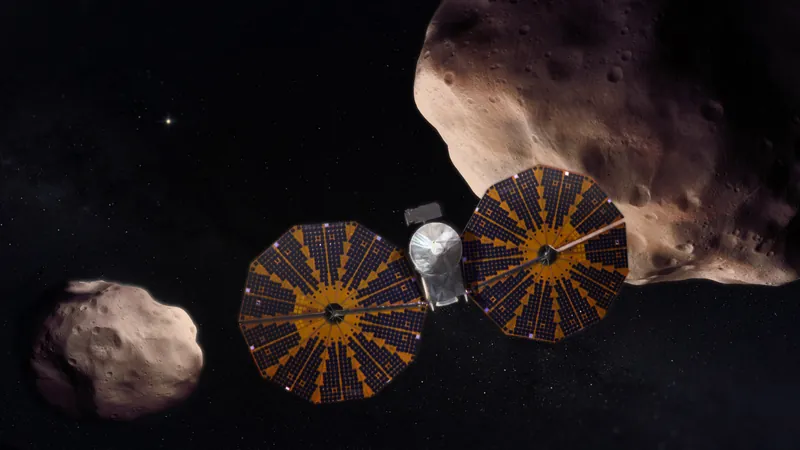
🌟 Unveiling the Cosmos: NASA's Lucy Mission Redefines Asteroid Exploration!
2025-05-06
Author: Jessica Wong
A Stellar Breakthrough in Space Exploration
BOULDER, Colorado — Asteroid aficionados, buckle up! NASA's Lucy spacecraft has just completed an exhilarating flyby of the asteroid Donaldjohanson, stirring excitement among scientists who are buzzing about the insights this cosmic wanderer may reveal.
The Mystery of Donaldjohanson
Hal Levison, the mission's principal investigator at the Southwest Research Institute (SwRI), describes the tantalizing unknowns surrounding Donaldjohanson. This asteroid acts like a fossil, offering crucial clues about planet formation. "These small bodies are the key to unlocking our planetary origins," Levison emphasized. "Each encounter is like a mini-experiment in understanding our solar system's history. "
An Asteroid Named for Discovery
Asteroid 52246 Donaldjohanson honors the famous paleoanthropologist who discovered the legendary Lucy hominid fossil in 1974. And just like that expedition changed our view of human evolution, Lucy’s mission is poised to reshape our understanding of celestial geology.
A 12-Year Celestial Tour
Lucy is no ordinary spacecraft; it’s on a spectacular 4-billion-mile, 12-year odyssey to visit 11 asteroids! Launched on October 16, 2021, it encountered Donaldjohanson on April 20, making it a warm-up act for its main event: the unexplored Trojan asteroids in Jupiter's orbit.
Groundbreaking Discoveries Await!
"We’re set to engage with five Trojan asteroids from April 2027 to March 2033. After that, I might just hang up my boots!" Levison joked. These Trojans hold secrets that could unveil the diversity of our solar system.
Surprise Encounters with Dinkinesh
In a thrilling November encounter, Lucy explored the minuscule main belt asteroid Dinkinesh, unveiling revelations including a contact binary satellite named Selam, marking a fascinating chapter in Lucy's scientific narrative. Levison remarked, "Dinkinesh was an unexpected marvel! Sometimes, our pre-flyby assumptions don’t quite match the facts."
Astounding Insights Ahead!
The latest data from Donaldjohanson was expected to align with earlier observations, but the details gathered have left scientists scratching their heads. "It looks like two ice cream cones fused together! We’re eager to unravel how this phenomenon formed," Levison said, hinting at profound revelations about cosmic collisions.
The Science of Collisions
Simone Marchi, Lucy’s deputy principal investigator, confirmed that Donaldjohanson is indeed a product of cosmic collisions. "These two objects must have collided gently, like walking speed, to stick together and form this unique shape, measuring 8 km by 2.5 km!"
A Golden Age for Asteroid Exploration
According to NASA's Thomas Statler, we are currently navigating a golden age of asteroid exploration. "Turning what were merely dots in the sky into tangible discoveries is revolutionary! These asteroids are the building blocks of planetary history, revealing secrets about our Earth and beyond."
Next Steps for Lucy
Katie Hegedus, Lockheed Martin's spacecraft encounter lead, highlighted the rigorous planning and scientific instrument integration that have made Lucy’s mission possible. "With precise maneuvering, we've ensured Lucy can successfully encounter each asteroid, harnessing the power of innovative solar arrays to operate at such vast distances."
A Legacy for Future Generations
Looking beyond 2033, when Lucy will pass by the Trojan asteroids Patroclus and Meneotius, Levison remains hopeful. "We expect there will be demand for an extended mission!" Inside the spacecraft, a plaque featuring messages from history's thinkers—including a special nod to the Beatles—serves not only as an emblem of our current civilization but as a beacon for any future discoverers.
The Messages We Leave Behind
This plaque carries thoughtful insights for our descendants, intended for those who could one day uncover it. As Levison puts it, "We aim to tell the story of our time, not for aliens, but for humans to understand our own history. The Lucy spacecraft is set to drift in its orbit for millions of years, a timeless messenger of our exploration spirit."


 Brasil (PT)
Brasil (PT)
 Canada (EN)
Canada (EN)
 Chile (ES)
Chile (ES)
 Česko (CS)
Česko (CS)
 대한민국 (KO)
대한민국 (KO)
 España (ES)
España (ES)
 France (FR)
France (FR)
 Hong Kong (EN)
Hong Kong (EN)
 Italia (IT)
Italia (IT)
 日本 (JA)
日本 (JA)
 Magyarország (HU)
Magyarország (HU)
 Norge (NO)
Norge (NO)
 Polska (PL)
Polska (PL)
 Schweiz (DE)
Schweiz (DE)
 Singapore (EN)
Singapore (EN)
 Sverige (SV)
Sverige (SV)
 Suomi (FI)
Suomi (FI)
 Türkiye (TR)
Türkiye (TR)
 الإمارات العربية المتحدة (AR)
الإمارات العربية المتحدة (AR)